Solved Exam: FINM01020R Introductory Finance and Accounting
VerifiedAdded on 2023/06/13
|11
|2121
|78
Homework Assignment
AI Summary
This document presents a solved examination paper for the Introductory Finance and Accounting module (FINM01020R). It includes detailed solutions to questions covering cost analysis, keep or drop decisions, cash budgeting, and financial statement preparation. The analysis extends to calculating net profit margins and current ratios to assess the business's financial health. Recommendations are provided for improving cash flow and investment strategies. The document also emphasizes factors beyond numerical analysis, such as employee efficiency and market demand, which influence business decisions. Desklib offers more resources like this to aid students in their studies.
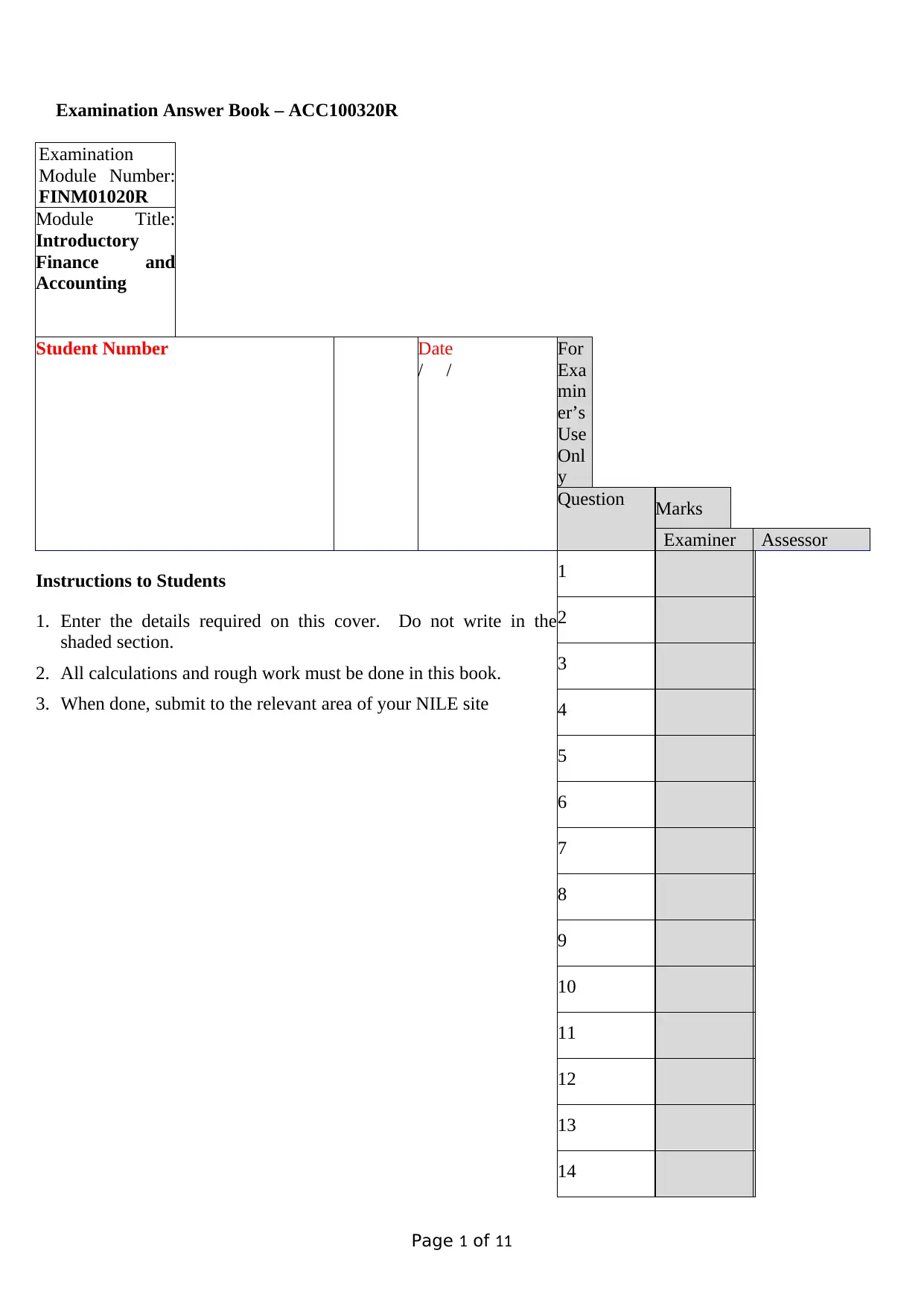
Examination Answer Book – ACC100320R
Examination
Module Number:
FINM01020R
Module Title:
Introductory
Finance and
Accounting
Student Number Date
/ /
For
Exa
min
er’s
Use
Onl
y
Question Marks
Examiner Assessor
Instructions to Students
1. Enter the details required on this cover. Do not write in the
shaded section.
2. All calculations and rough work must be done in this book.
3. When done, submit to the relevant area of your NILE site
1
2
3
4
5
6
7
8
9
10
11
12
13
14
Page 1 of 11
Examination
Module Number:
FINM01020R
Module Title:
Introductory
Finance and
Accounting
Student Number Date
/ /
For
Exa
min
er’s
Use
Onl
y
Question Marks
Examiner Assessor
Instructions to Students
1. Enter the details required on this cover. Do not write in the
shaded section.
2. All calculations and rough work must be done in this book.
3. When done, submit to the relevant area of your NILE site
1
2
3
4
5
6
7
8
9
10
11
12
13
14
Page 1 of 11
Paraphrase This Document
Need a fresh take? Get an instant paraphrase of this document with our AI Paraphraser
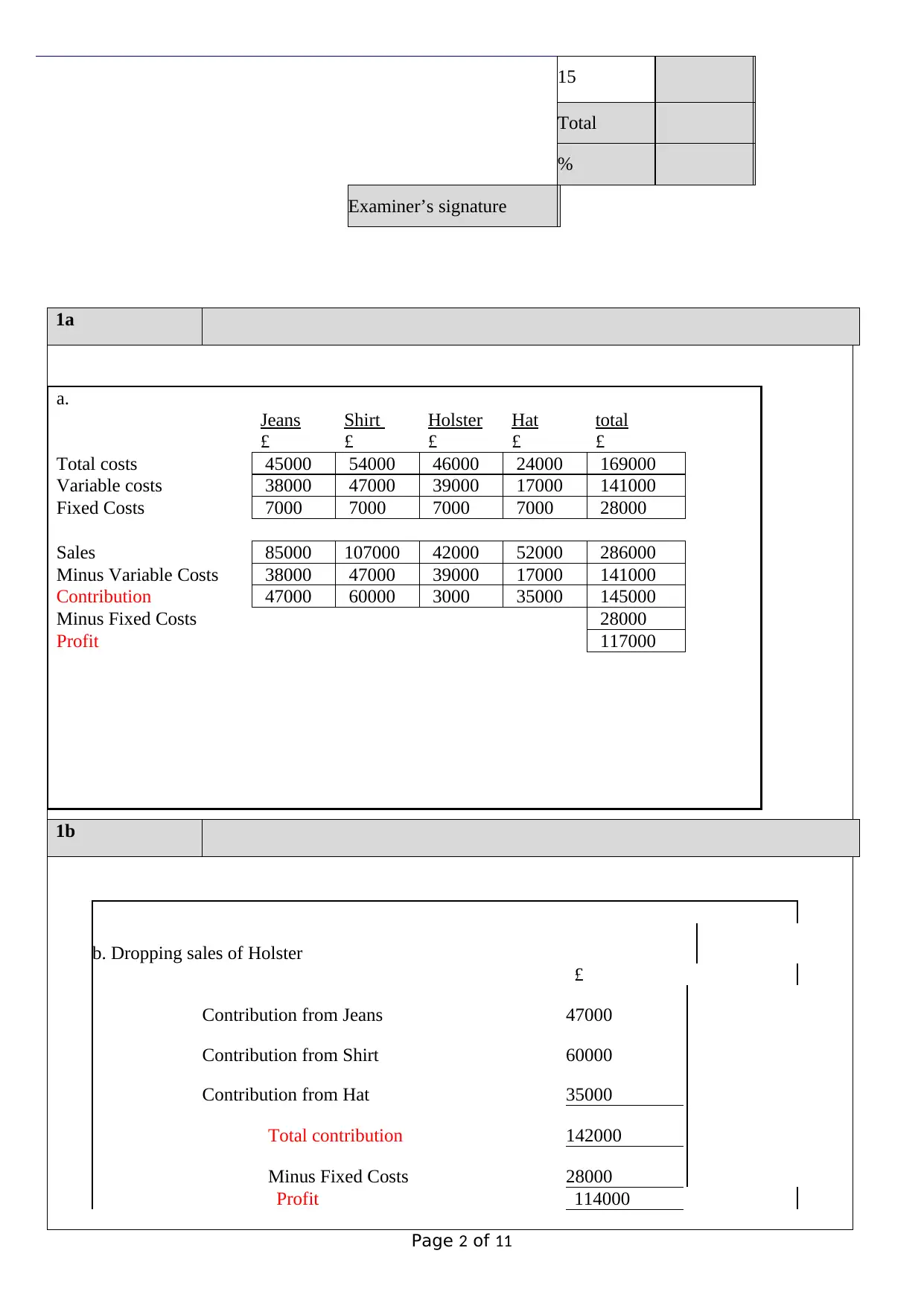
15
Total
%
Examiner’s signature
1a
a.
Jeans Shirt Holster Hat total
£ £ £ £ £
Total costs 45000 54000 46000 24000 169000
Variable costs 38000 47000 39000 17000 141000
Fixed Costs 7000 7000 7000 7000 28000
Sales 85000 107000 42000 52000 286000
Minus Variable Costs 38000 47000 39000 17000 141000
Contribution 47000 60000 3000 35000 145000
Minus Fixed Costs 28000
Profit 117000
1b
b. Dropping sales of Holster
£
Contribution from Jeans 47000
Contribution from Shirt 60000
Contribution from Hat 35000
Total contribution 142000
Minus Fixed Costs 28000
Profit 114000
Page 2 of 11
Total
%
Examiner’s signature
1a
a.
Jeans Shirt Holster Hat total
£ £ £ £ £
Total costs 45000 54000 46000 24000 169000
Variable costs 38000 47000 39000 17000 141000
Fixed Costs 7000 7000 7000 7000 28000
Sales 85000 107000 42000 52000 286000
Minus Variable Costs 38000 47000 39000 17000 141000
Contribution 47000 60000 3000 35000 145000
Minus Fixed Costs 28000
Profit 117000
1b
b. Dropping sales of Holster
£
Contribution from Jeans 47000
Contribution from Shirt 60000
Contribution from Hat 35000
Total contribution 142000
Minus Fixed Costs 28000
Profit 114000
Page 2 of 11
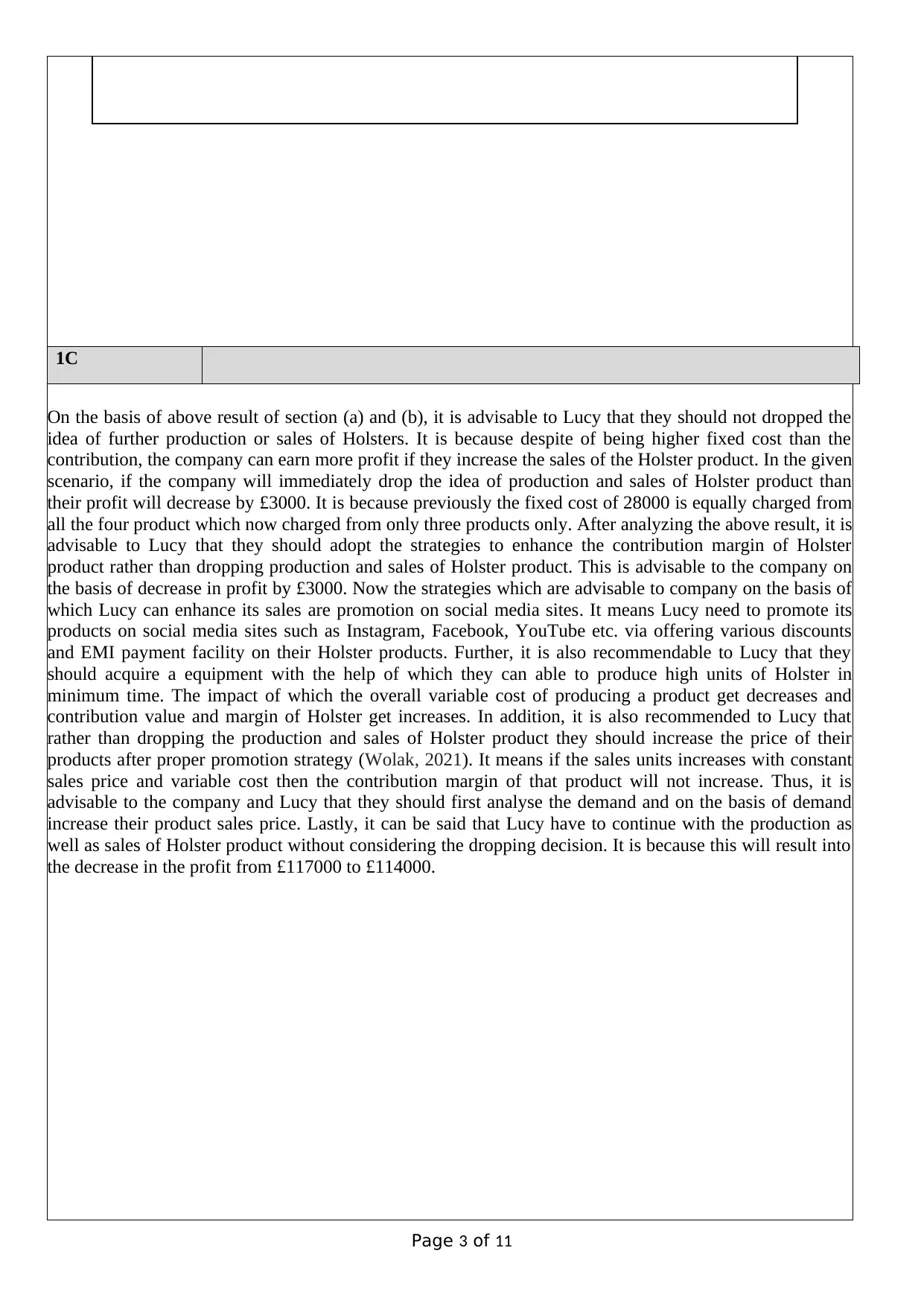
1C
On the basis of above result of section (a) and (b), it is advisable to Lucy that they should not dropped the
idea of further production or sales of Holsters. It is because despite of being higher fixed cost than the
contribution, the company can earn more profit if they increase the sales of the Holster product. In the given
scenario, if the company will immediately drop the idea of production and sales of Holster product than
their profit will decrease by £3000. It is because previously the fixed cost of 28000 is equally charged from
all the four product which now charged from only three products only. After analyzing the above result, it is
advisable to Lucy that they should adopt the strategies to enhance the contribution margin of Holster
product rather than dropping production and sales of Holster product. This is advisable to the company on
the basis of decrease in profit by £3000. Now the strategies which are advisable to company on the basis of
which Lucy can enhance its sales are promotion on social media sites. It means Lucy need to promote its
products on social media sites such as Instagram, Facebook, YouTube etc. via offering various discounts
and EMI payment facility on their Holster products. Further, it is also recommendable to Lucy that they
should acquire a equipment with the help of which they can able to produce high units of Holster in
minimum time. The impact of which the overall variable cost of producing a product get decreases and
contribution value and margin of Holster get increases. In addition, it is also recommended to Lucy that
rather than dropping the production and sales of Holster product they should increase the price of their
products after proper promotion strategy (Wolak, 2021). It means if the sales units increases with constant
sales price and variable cost then the contribution margin of that product will not increase. Thus, it is
advisable to the company and Lucy that they should first analyse the demand and on the basis of demand
increase their product sales price. Lastly, it can be said that Lucy have to continue with the production as
well as sales of Holster product without considering the dropping decision. It is because this will result into
the decrease in the profit from £117000 to £114000.
Page 3 of 11
On the basis of above result of section (a) and (b), it is advisable to Lucy that they should not dropped the
idea of further production or sales of Holsters. It is because despite of being higher fixed cost than the
contribution, the company can earn more profit if they increase the sales of the Holster product. In the given
scenario, if the company will immediately drop the idea of production and sales of Holster product than
their profit will decrease by £3000. It is because previously the fixed cost of 28000 is equally charged from
all the four product which now charged from only three products only. After analyzing the above result, it is
advisable to Lucy that they should adopt the strategies to enhance the contribution margin of Holster
product rather than dropping production and sales of Holster product. This is advisable to the company on
the basis of decrease in profit by £3000. Now the strategies which are advisable to company on the basis of
which Lucy can enhance its sales are promotion on social media sites. It means Lucy need to promote its
products on social media sites such as Instagram, Facebook, YouTube etc. via offering various discounts
and EMI payment facility on their Holster products. Further, it is also recommendable to Lucy that they
should acquire a equipment with the help of which they can able to produce high units of Holster in
minimum time. The impact of which the overall variable cost of producing a product get decreases and
contribution value and margin of Holster get increases. In addition, it is also recommended to Lucy that
rather than dropping the production and sales of Holster product they should increase the price of their
products after proper promotion strategy (Wolak, 2021). It means if the sales units increases with constant
sales price and variable cost then the contribution margin of that product will not increase. Thus, it is
advisable to the company and Lucy that they should first analyse the demand and on the basis of demand
increase their product sales price. Lastly, it can be said that Lucy have to continue with the production as
well as sales of Holster product without considering the dropping decision. It is because this will result into
the decrease in the profit from £117000 to £114000.
Page 3 of 11
⊘ This is a preview!⊘
Do you want full access?
Subscribe today to unlock all pages.

Trusted by 1+ million students worldwide
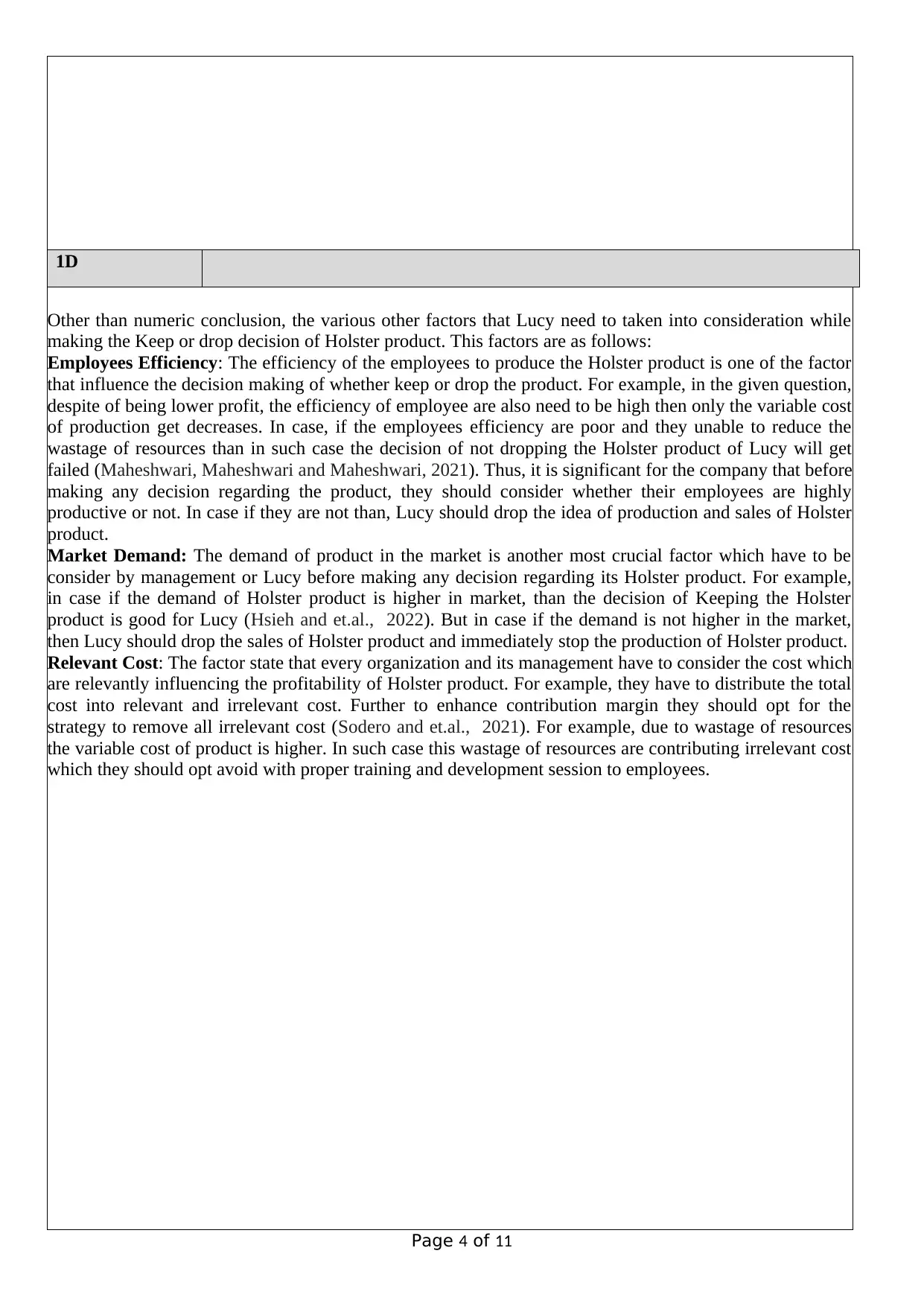
1D
Other than numeric conclusion, the various other factors that Lucy need to taken into consideration while
making the Keep or drop decision of Holster product. This factors are as follows:
Employees Efficiency: The efficiency of the employees to produce the Holster product is one of the factor
that influence the decision making of whether keep or drop the product. For example, in the given question,
despite of being lower profit, the efficiency of employee are also need to be high then only the variable cost
of production get decreases. In case, if the employees efficiency are poor and they unable to reduce the
wastage of resources than in such case the decision of not dropping the Holster product of Lucy will get
failed (Maheshwari, Maheshwari and Maheshwari, 2021). Thus, it is significant for the company that before
making any decision regarding the product, they should consider whether their employees are highly
productive or not. In case if they are not than, Lucy should drop the idea of production and sales of Holster
product.
Market Demand: The demand of product in the market is another most crucial factor which have to be
consider by management or Lucy before making any decision regarding its Holster product. For example,
in case if the demand of Holster product is higher in market, than the decision of Keeping the Holster
product is good for Lucy (Hsieh and et.al., 2022). But in case if the demand is not higher in the market,
then Lucy should drop the sales of Holster product and immediately stop the production of Holster product.
Relevant Cost: The factor state that every organization and its management have to consider the cost which
are relevantly influencing the profitability of Holster product. For example, they have to distribute the total
cost into relevant and irrelevant cost. Further to enhance contribution margin they should opt for the
strategy to remove all irrelevant cost (Sodero and et.al., 2021). For example, due to wastage of resources
the variable cost of product is higher. In such case this wastage of resources are contributing irrelevant cost
which they should opt avoid with proper training and development session to employees.
Page 4 of 11
Other than numeric conclusion, the various other factors that Lucy need to taken into consideration while
making the Keep or drop decision of Holster product. This factors are as follows:
Employees Efficiency: The efficiency of the employees to produce the Holster product is one of the factor
that influence the decision making of whether keep or drop the product. For example, in the given question,
despite of being lower profit, the efficiency of employee are also need to be high then only the variable cost
of production get decreases. In case, if the employees efficiency are poor and they unable to reduce the
wastage of resources than in such case the decision of not dropping the Holster product of Lucy will get
failed (Maheshwari, Maheshwari and Maheshwari, 2021). Thus, it is significant for the company that before
making any decision regarding the product, they should consider whether their employees are highly
productive or not. In case if they are not than, Lucy should drop the idea of production and sales of Holster
product.
Market Demand: The demand of product in the market is another most crucial factor which have to be
consider by management or Lucy before making any decision regarding its Holster product. For example,
in case if the demand of Holster product is higher in market, than the decision of Keeping the Holster
product is good for Lucy (Hsieh and et.al., 2022). But in case if the demand is not higher in the market,
then Lucy should drop the sales of Holster product and immediately stop the production of Holster product.
Relevant Cost: The factor state that every organization and its management have to consider the cost which
are relevantly influencing the profitability of Holster product. For example, they have to distribute the total
cost into relevant and irrelevant cost. Further to enhance contribution margin they should opt for the
strategy to remove all irrelevant cost (Sodero and et.al., 2021). For example, due to wastage of resources
the variable cost of product is higher. In such case this wastage of resources are contributing irrelevant cost
which they should opt avoid with proper training and development session to employees.
Page 4 of 11
Paraphrase This Document
Need a fresh take? Get an instant paraphrase of this document with our AI Paraphraser
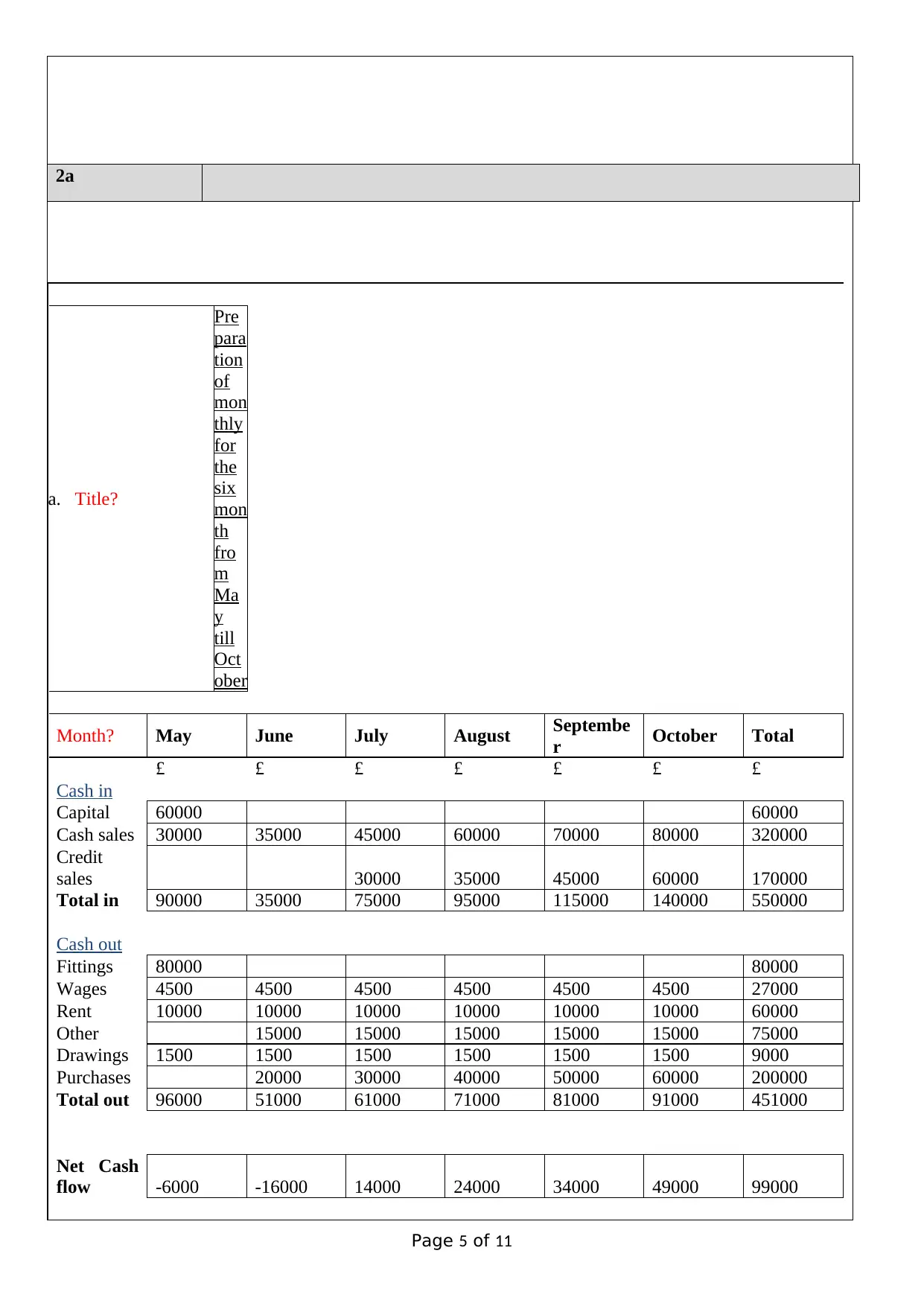
2a
a. Title?
Pre
para
tion
of
mon
thly
for
the
six
mon
th
fro
m
Ma
y
till
Oct
ober
Month? May June July August Septembe
r October Total
£ £ £ £ £ £ £
Cash in
Capital 60000 60000
Cash sales 30000 35000 45000 60000 70000 80000 320000
Credit
sales 30000 35000 45000 60000 170000
Total in 90000 35000 75000 95000 115000 140000 550000
Cash out
Fittings 80000 80000
Wages 4500 4500 4500 4500 4500 4500 27000
Rent 10000 10000 10000 10000 10000 10000 60000
Other 15000 15000 15000 15000 15000 75000
Drawings 1500 1500 1500 1500 1500 1500 9000
Purchases 20000 30000 40000 50000 60000 200000
Total out 96000 51000 61000 71000 81000 91000 451000
Net Cash
flow -6000 -16000 14000 24000 34000 49000 99000
Page 5 of 11
a. Title?
Pre
para
tion
of
mon
thly
for
the
six
mon
th
fro
m
Ma
y
till
Oct
ober
Month? May June July August Septembe
r October Total
£ £ £ £ £ £ £
Cash in
Capital 60000 60000
Cash sales 30000 35000 45000 60000 70000 80000 320000
Credit
sales 30000 35000 45000 60000 170000
Total in 90000 35000 75000 95000 115000 140000 550000
Cash out
Fittings 80000 80000
Wages 4500 4500 4500 4500 4500 4500 27000
Rent 10000 10000 10000 10000 10000 10000 60000
Other 15000 15000 15000 15000 15000 75000
Drawings 1500 1500 1500 1500 1500 1500 9000
Purchases 20000 30000 40000 50000 60000 200000
Total out 96000 51000 61000 71000 81000 91000 451000
Net Cash
flow -6000 -16000 14000 24000 34000 49000 99000
Page 5 of 11
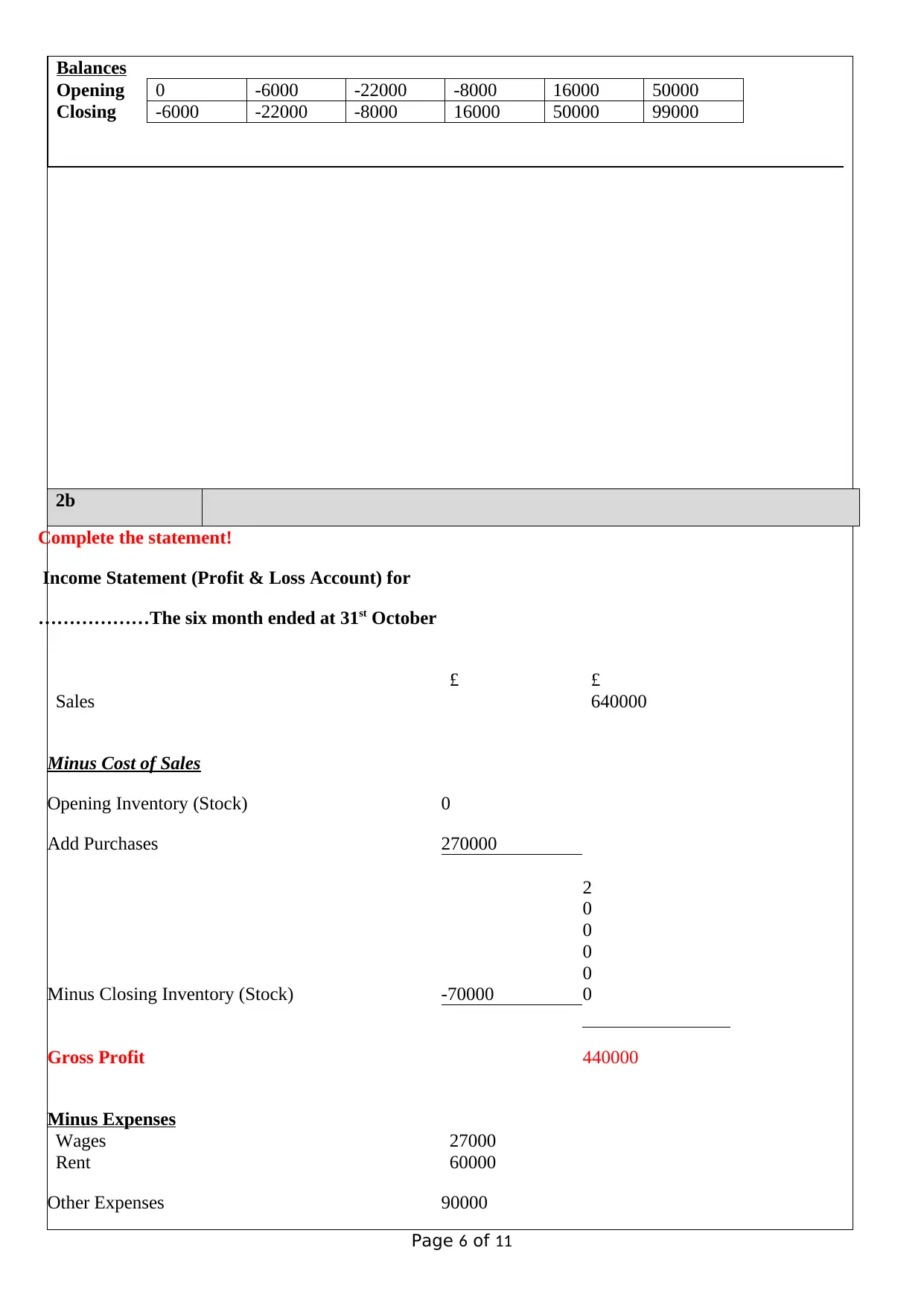
Balances
Opening 0 -6000 -22000 -8000 16000 50000
Closing -6000 -22000 -8000 16000 50000 99000
2b
Complete the statement!
Income Statement (Profit & Loss Account) for
………………The six month ended at 31st October
£ £
Sales 640000
Minus Cost of Sales
Opening Inventory (Stock) 0
Add Purchases 270000
Minus Closing Inventory (Stock) -70000
2
0
0
0
0
0
Gross Profit 440000
Minus Expenses
Wages 27000
Rent 60000
Other Expenses 90000
Page 6 of 11
Opening 0 -6000 -22000 -8000 16000 50000
Closing -6000 -22000 -8000 16000 50000 99000
2b
Complete the statement!
Income Statement (Profit & Loss Account) for
………………The six month ended at 31st October
£ £
Sales 640000
Minus Cost of Sales
Opening Inventory (Stock) 0
Add Purchases 270000
Minus Closing Inventory (Stock) -70000
2
0
0
0
0
0
Gross Profit 440000
Minus Expenses
Wages 27000
Rent 60000
Other Expenses 90000
Page 6 of 11
⊘ This is a preview!⊘
Do you want full access?
Subscribe today to unlock all pages.

Trusted by 1+ million students worldwide
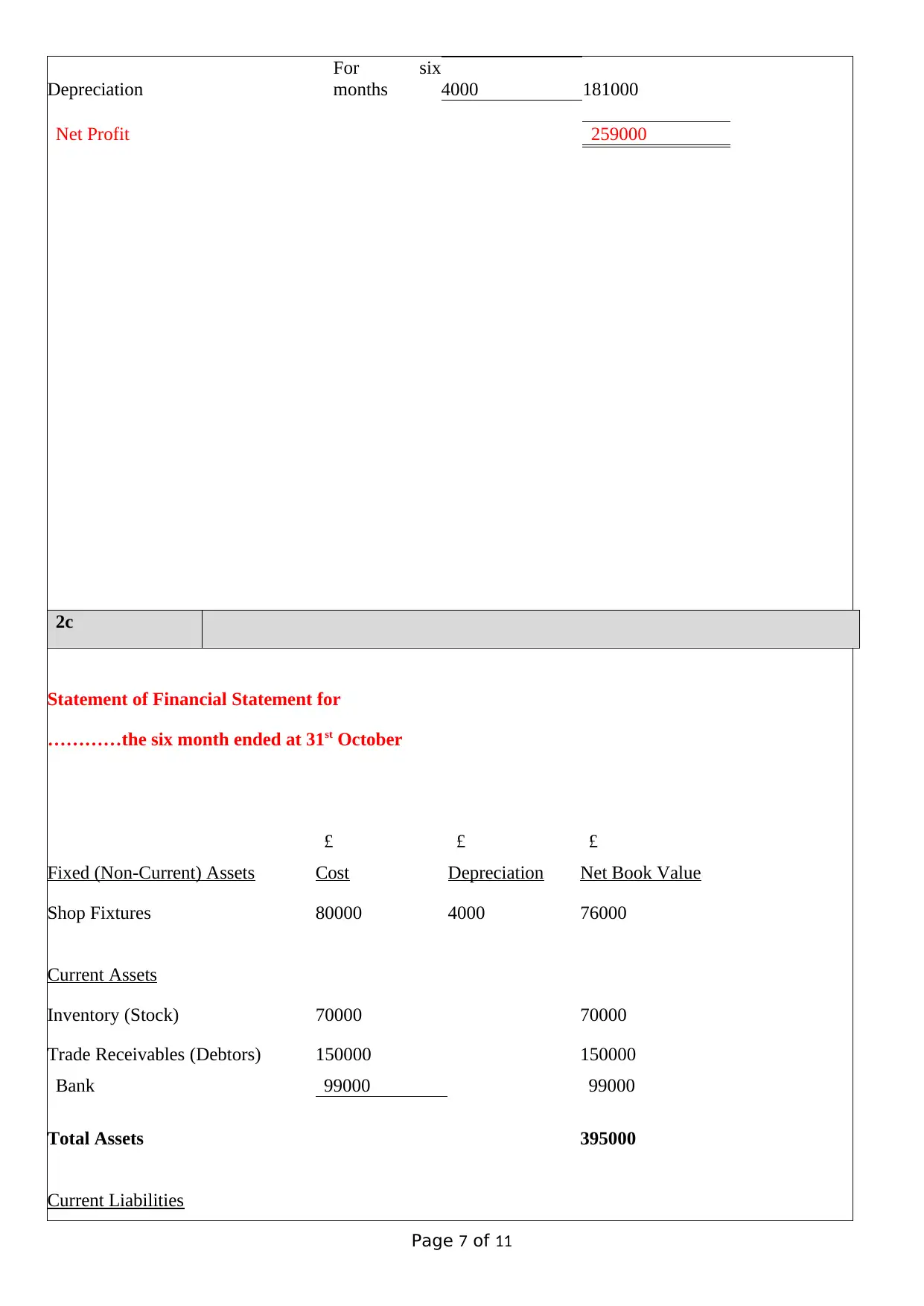
Depreciation
For six
months 4000 181000
Net Profit 259000
2c
Statement of Financial Statement for
…………the six month ended at 31st October
£ £ £
Fixed (Non-Current) Assets Cost Depreciation Net Book Value
Shop Fixtures 80000 4000 76000
Current Assets
Inventory (Stock) 70000 70000
Trade Receivables (Debtors) 150000 150000
Bank 99000 99000
Total Assets 395000
Current Liabilities
Page 7 of 11
For six
months 4000 181000
Net Profit 259000
2c
Statement of Financial Statement for
…………the six month ended at 31st October
£ £ £
Fixed (Non-Current) Assets Cost Depreciation Net Book Value
Shop Fixtures 80000 4000 76000
Current Assets
Inventory (Stock) 70000 70000
Trade Receivables (Debtors) 150000 150000
Bank 99000 99000
Total Assets 395000
Current Liabilities
Page 7 of 11
Paraphrase This Document
Need a fresh take? Get an instant paraphrase of this document with our AI Paraphraser
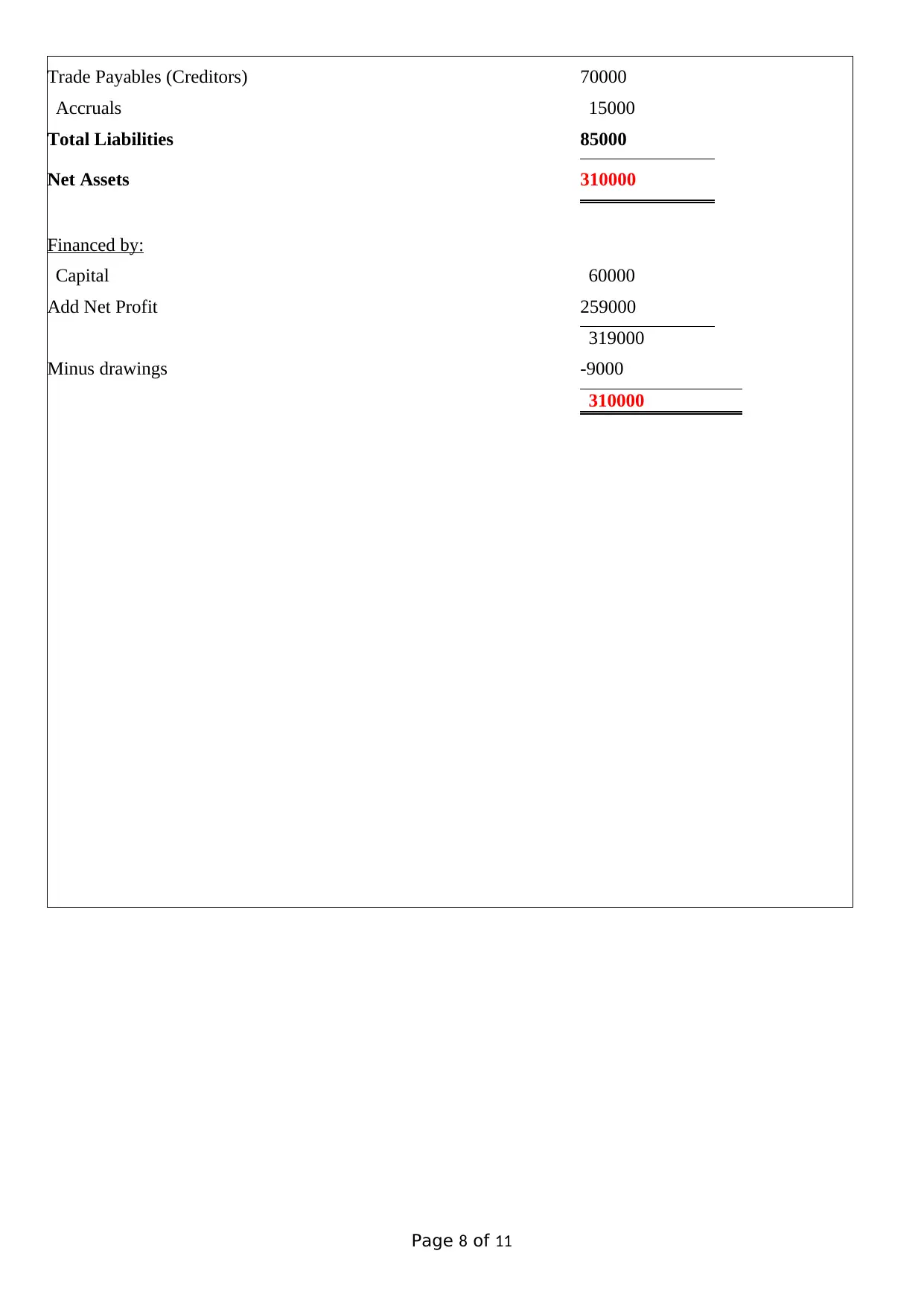
Trade Payables (Creditors) 70000
Accruals 15000
Total Liabilities 85000
Net Assets 310000
Financed by:
Capital 60000
Add Net Profit 259000
319000
Minus drawings -9000
310000
Page 8 of 11
Accruals 15000
Total Liabilities 85000
Net Assets 310000
Financed by:
Capital 60000
Add Net Profit 259000
319000
Minus drawings -9000
310000
Page 8 of 11
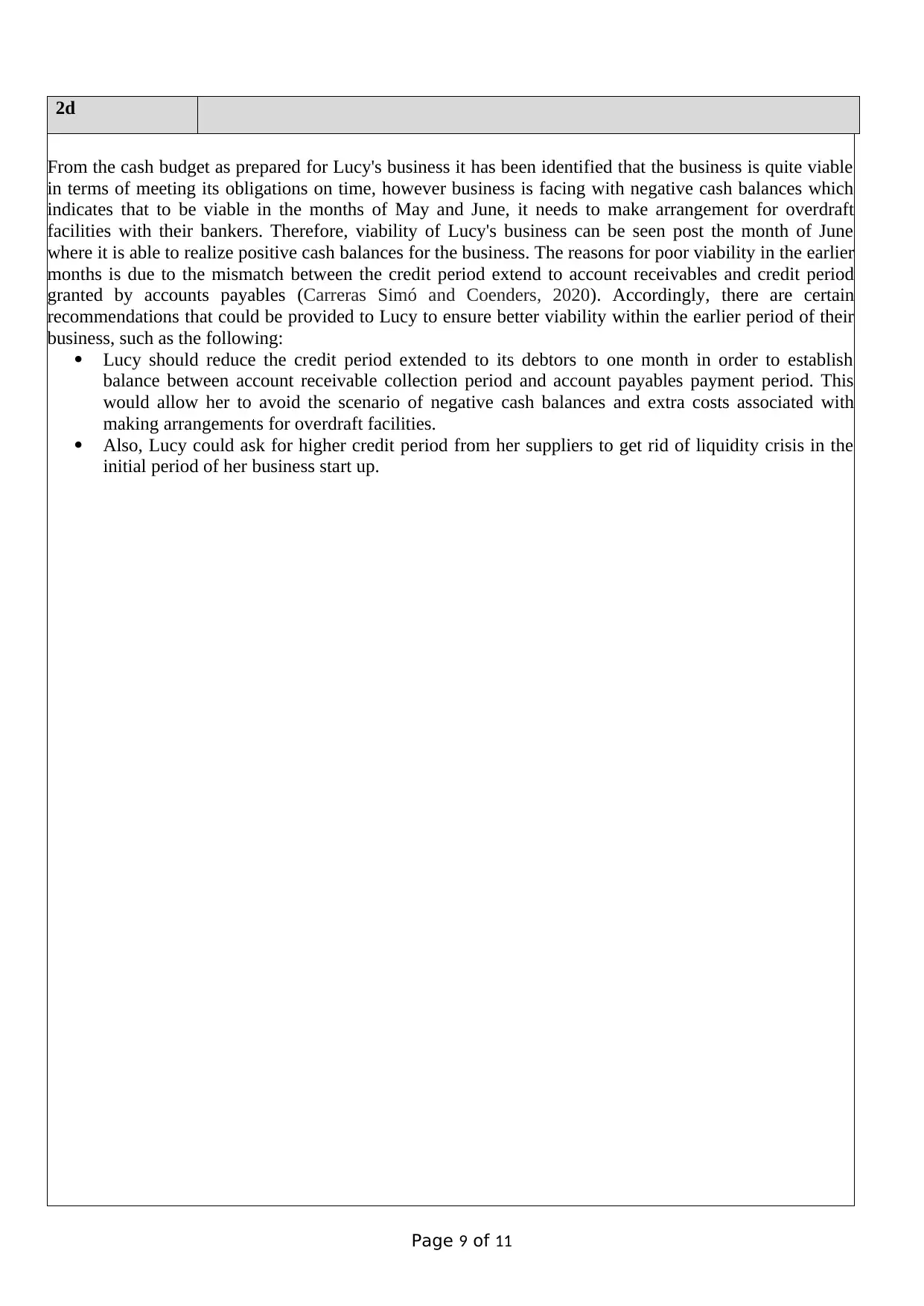
2d
From the cash budget as prepared for Lucy's business it has been identified that the business is quite viable
in terms of meeting its obligations on time, however business is facing with negative cash balances which
indicates that to be viable in the months of May and June, it needs to make arrangement for overdraft
facilities with their bankers. Therefore, viability of Lucy's business can be seen post the month of June
where it is able to realize positive cash balances for the business. The reasons for poor viability in the earlier
months is due to the mismatch between the credit period extend to account receivables and credit period
granted by accounts payables (Carreras Simó and Coenders, 2020). Accordingly, there are certain
recommendations that could be provided to Lucy to ensure better viability within the earlier period of their
business, such as the following:
Lucy should reduce the credit period extended to its debtors to one month in order to establish
balance between account receivable collection period and account payables payment period. This
would allow her to avoid the scenario of negative cash balances and extra costs associated with
making arrangements for overdraft facilities.
Also, Lucy could ask for higher credit period from her suppliers to get rid of liquidity crisis in the
initial period of her business start up.
Page 9 of 11
From the cash budget as prepared for Lucy's business it has been identified that the business is quite viable
in terms of meeting its obligations on time, however business is facing with negative cash balances which
indicates that to be viable in the months of May and June, it needs to make arrangement for overdraft
facilities with their bankers. Therefore, viability of Lucy's business can be seen post the month of June
where it is able to realize positive cash balances for the business. The reasons for poor viability in the earlier
months is due to the mismatch between the credit period extend to account receivables and credit period
granted by accounts payables (Carreras Simó and Coenders, 2020). Accordingly, there are certain
recommendations that could be provided to Lucy to ensure better viability within the earlier period of their
business, such as the following:
Lucy should reduce the credit period extended to its debtors to one month in order to establish
balance between account receivable collection period and account payables payment period. This
would allow her to avoid the scenario of negative cash balances and extra costs associated with
making arrangements for overdraft facilities.
Also, Lucy could ask for higher credit period from her suppliers to get rid of liquidity crisis in the
initial period of her business start up.
Page 9 of 11
⊘ This is a preview!⊘
Do you want full access?
Subscribe today to unlock all pages.

Trusted by 1+ million students worldwide
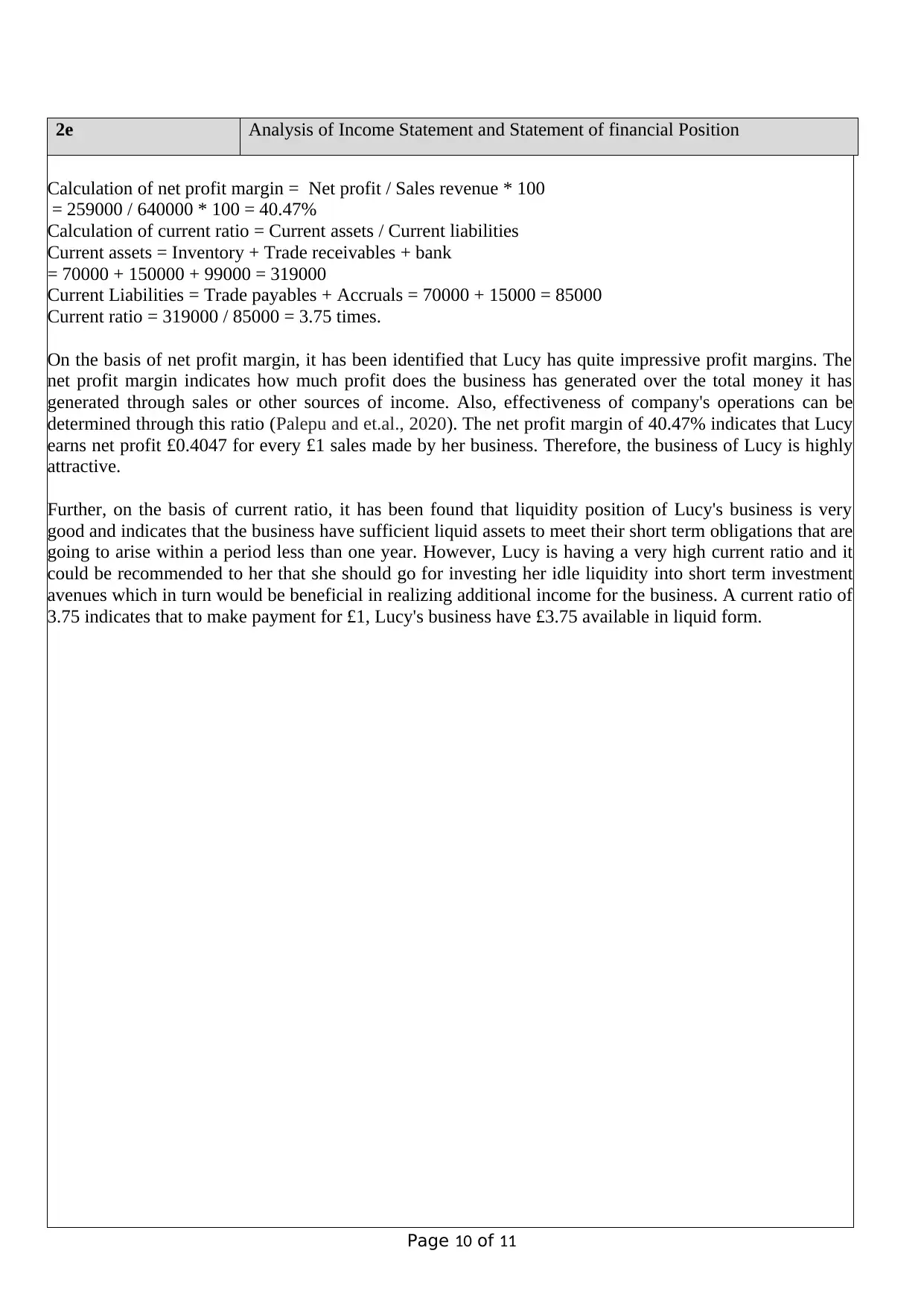
2e Analysis of Income Statement and Statement of financial Position
Calculation of net profit margin = Net profit / Sales revenue * 100
= 259000 / 640000 * 100 = 40.47%
Calculation of current ratio = Current assets / Current liabilities
Current assets = Inventory + Trade receivables + bank
= 70000 + 150000 + 99000 = 319000
Current Liabilities = Trade payables + Accruals = 70000 + 15000 = 85000
Current ratio = 319000 / 85000 = 3.75 times.
On the basis of net profit margin, it has been identified that Lucy has quite impressive profit margins. The
net profit margin indicates how much profit does the business has generated over the total money it has
generated through sales or other sources of income. Also, effectiveness of company's operations can be
determined through this ratio (Palepu and et.al., 2020). The net profit margin of 40.47% indicates that Lucy
earns net profit £0.4047 for every £1 sales made by her business. Therefore, the business of Lucy is highly
attractive.
Further, on the basis of current ratio, it has been found that liquidity position of Lucy's business is very
good and indicates that the business have sufficient liquid assets to meet their short term obligations that are
going to arise within a period less than one year. However, Lucy is having a very high current ratio and it
could be recommended to her that she should go for investing her idle liquidity into short term investment
avenues which in turn would be beneficial in realizing additional income for the business. A current ratio of
3.75 indicates that to make payment for £1, Lucy's business have £3.75 available in liquid form.
Page 10 of 11
Calculation of net profit margin = Net profit / Sales revenue * 100
= 259000 / 640000 * 100 = 40.47%
Calculation of current ratio = Current assets / Current liabilities
Current assets = Inventory + Trade receivables + bank
= 70000 + 150000 + 99000 = 319000
Current Liabilities = Trade payables + Accruals = 70000 + 15000 = 85000
Current ratio = 319000 / 85000 = 3.75 times.
On the basis of net profit margin, it has been identified that Lucy has quite impressive profit margins. The
net profit margin indicates how much profit does the business has generated over the total money it has
generated through sales or other sources of income. Also, effectiveness of company's operations can be
determined through this ratio (Palepu and et.al., 2020). The net profit margin of 40.47% indicates that Lucy
earns net profit £0.4047 for every £1 sales made by her business. Therefore, the business of Lucy is highly
attractive.
Further, on the basis of current ratio, it has been found that liquidity position of Lucy's business is very
good and indicates that the business have sufficient liquid assets to meet their short term obligations that are
going to arise within a period less than one year. However, Lucy is having a very high current ratio and it
could be recommended to her that she should go for investing her idle liquidity into short term investment
avenues which in turn would be beneficial in realizing additional income for the business. A current ratio of
3.75 indicates that to make payment for £1, Lucy's business have £3.75 available in liquid form.
Page 10 of 11
Paraphrase This Document
Need a fresh take? Get an instant paraphrase of this document with our AI Paraphraser
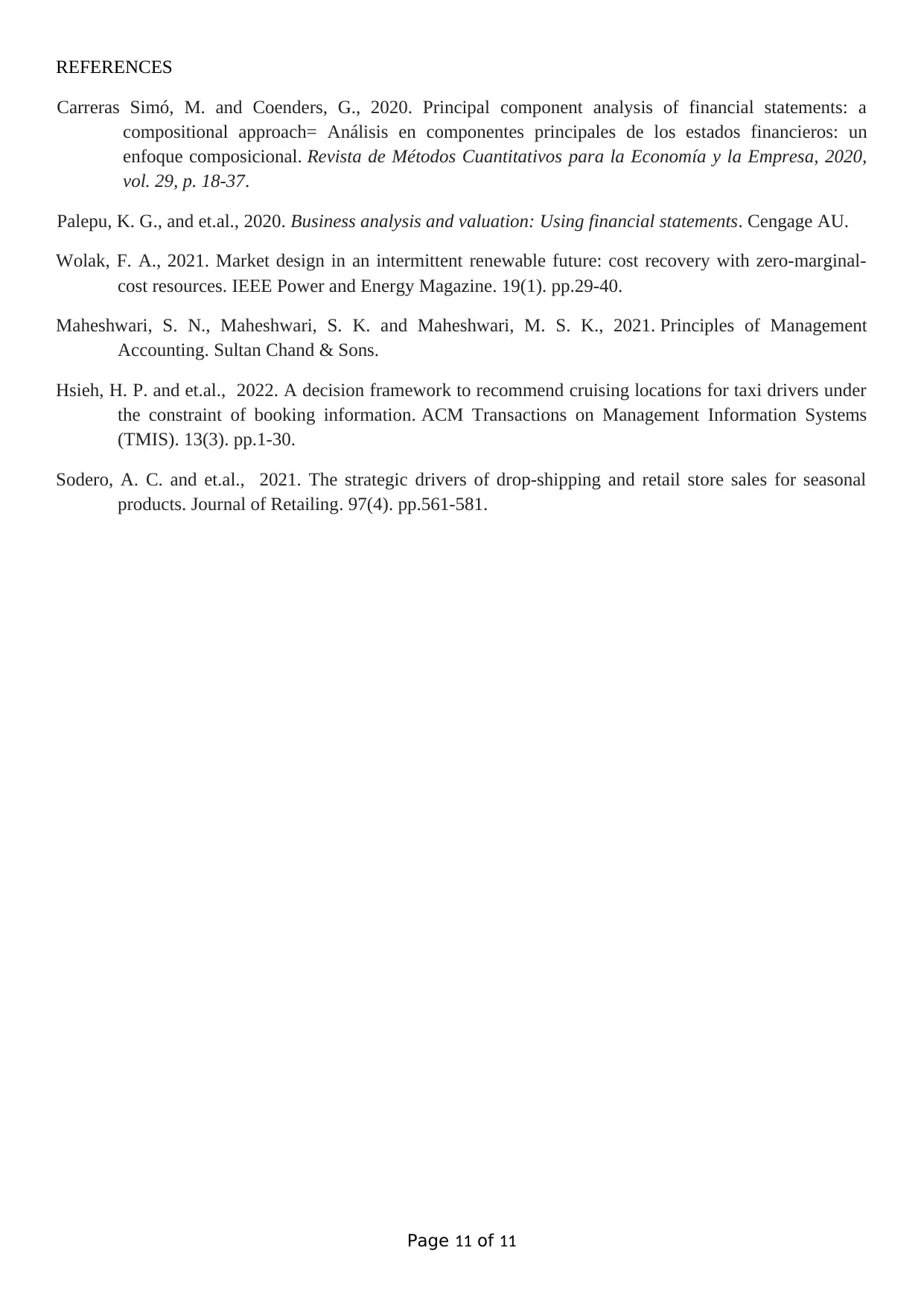
REFERENCES
Carreras Simó, M. and Coenders, G., 2020. Principal component analysis of financial statements: a
compositional approach= Análisis en componentes principales de los estados financieros: un
enfoque composicional. Revista de Métodos Cuantitativos para la Economía y la Empresa, 2020,
vol. 29, p. 18-37.
Palepu, K. G., and et.al., 2020. Business analysis and valuation: Using financial statements. Cengage AU.
Wolak, F. A., 2021. Market design in an intermittent renewable future: cost recovery with zero-marginal-
cost resources. IEEE Power and Energy Magazine. 19(1). pp.29-40.
Maheshwari, S. N., Maheshwari, S. K. and Maheshwari, M. S. K., 2021. Principles of Management
Accounting. Sultan Chand & Sons.
Hsieh, H. P. and et.al., 2022. A decision framework to recommend cruising locations for taxi drivers under
the constraint of booking information. ACM Transactions on Management Information Systems
(TMIS). 13(3). pp.1-30.
Sodero, A. C. and et.al., 2021. The strategic drivers of drop-shipping and retail store sales for seasonal
products. Journal of Retailing. 97(4). pp.561-581.
Page 11 of 11
Carreras Simó, M. and Coenders, G., 2020. Principal component analysis of financial statements: a
compositional approach= Análisis en componentes principales de los estados financieros: un
enfoque composicional. Revista de Métodos Cuantitativos para la Economía y la Empresa, 2020,
vol. 29, p. 18-37.
Palepu, K. G., and et.al., 2020. Business analysis and valuation: Using financial statements. Cengage AU.
Wolak, F. A., 2021. Market design in an intermittent renewable future: cost recovery with zero-marginal-
cost resources. IEEE Power and Energy Magazine. 19(1). pp.29-40.
Maheshwari, S. N., Maheshwari, S. K. and Maheshwari, M. S. K., 2021. Principles of Management
Accounting. Sultan Chand & Sons.
Hsieh, H. P. and et.al., 2022. A decision framework to recommend cruising locations for taxi drivers under
the constraint of booking information. ACM Transactions on Management Information Systems
(TMIS). 13(3). pp.1-30.
Sodero, A. C. and et.al., 2021. The strategic drivers of drop-shipping and retail store sales for seasonal
products. Journal of Retailing. 97(4). pp.561-581.
Page 11 of 11
1 out of 11
Your All-in-One AI-Powered Toolkit for Academic Success.
+13062052269
info@desklib.com
Available 24*7 on WhatsApp / Email
![[object Object]](/_next/static/media/star-bottom.7253800d.svg)
Unlock your academic potential
Copyright © 2020–2025 A2Z Services. All Rights Reserved. Developed and managed by ZUCOL.
